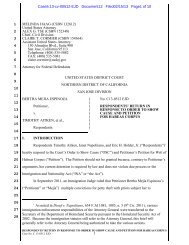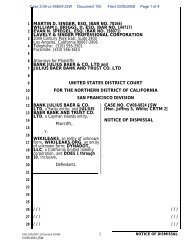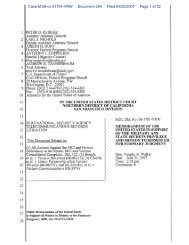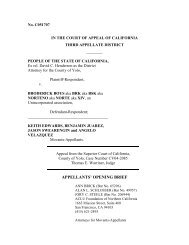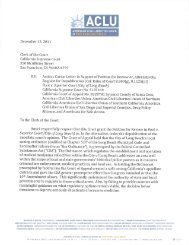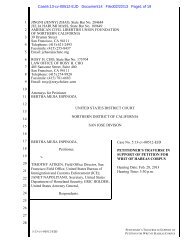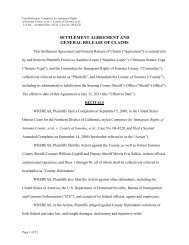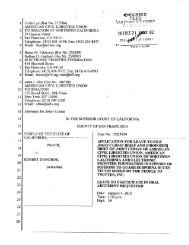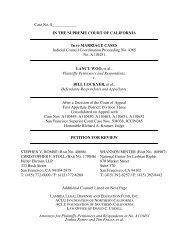Stun Gun Fallacy - ACLU of Northern California
Stun Gun Fallacy - ACLU of Northern California
Stun Gun Fallacy - ACLU of Northern California
You also want an ePaper? Increase the reach of your titles
YUMPU automatically turns print PDFs into web optimized ePapers that Google loves.
eported and/or filed lawsuits against Taser International for<br />
injuries ranging from ruptured disks and other fractures to<br />
joint injuries. Moreover, the Phoenix Police Department,<br />
which once strongly recommended <strong>of</strong>ficer exposure during<br />
training, now prohibits voluntary exposures. 67 In the month<br />
<strong>of</strong> August, 2005, alone, <strong>of</strong>ficers in at least five states filed suit<br />
against Taser International for Taser related injuries, including<br />
multiple spinal fractures, burns, a shoulder dislocation, and<br />
s<strong>of</strong>t tissue injuries. 68<br />
Despite increased scrutiny <strong>of</strong> Taser<br />
stun guns in the news media and elsewhere,<br />
the latest version <strong>of</strong> the training<br />
materials—Version 12—contains many<br />
similar problems. Some <strong>of</strong> the provisions<br />
have been changed. For example, Version<br />
12 contains warnings in small print<br />
that state “the very nature <strong>of</strong> physical<br />
incapacitation involves a degree <strong>of</strong> risk<br />
that someone will get hurt or may even<br />
be killed due to physical exertion.” 69 It<br />
also states that “in rare instances, subjects<br />
may experience physical exertion<br />
type injuries including injuries to muscles,<br />
tendons, ligaments, backs, joints<br />
and stress fractures.” 70<br />
However, on four separate occasions,<br />
the materials continue to indicate that<br />
Tasers are harmless. The materials<br />
contain virtually identical language to<br />
Version 11 and state:<br />
There have been no long-term injuries caused by the<br />
TASER. 71<br />
Deputy Powers and countless other <strong>of</strong>ficers who have suffered<br />
long-term injuries from the stun gun—and even Taser’s<br />
own doctor—might disagree. The problem, <strong>of</strong> course, is that<br />
police departments in <strong>California</strong> and around the nation rely<br />
on Taser training materials to educate their <strong>of</strong>ficers. Certainly<br />
Version 12 has some additional warnings that Version 11 and<br />
other prior versions did not have, but most departments do<br />
not have this most recent version—relying on older versions<br />
—and even the most recent version grossly misrepresents the<br />
potential damage Tasers can cause.<br />
Multiple Shocks<br />
Similarly, Taser training materials encourage multiple shocks<br />
and downplay the risks. Version 11 indicates that 32 percent<br />
<strong>of</strong> field applications use more than one “cycle,” or hit, and,<br />
in the instructor notes section, the materials state that “the<br />
students should anticipate using additional cycles to subdue<br />
suspects.” 72<br />
IN THE MONTH OF<br />
AUGUST 2005 ALONE,<br />
OFFICERS IN AT LEAST<br />
FIVE STATES FILED<br />
SUIT AGAINST TASER<br />
INTERNATIONAL<br />
FOR TASER RELATED<br />
INJURIES INCLUDING<br />
MULTIPLE SPINAL<br />
FRACTURES, BURNS,<br />
A SHOULDER<br />
DISLOCATION, AND SOFT<br />
TISSUE INJURIES.<br />
Version 12 does contain a warning about the potential dangers<br />
<strong>of</strong> multiple cycles and urges avoiding “prolonged applications<br />
whenever practicable.” 73 However, another slide titled<br />
“Follow up Action” states that the “Taser operator should be<br />
prepared to apply additional cycles if necessary.” 74 And in response<br />
to the question: “When should an <strong>of</strong>ficer be prepared<br />
to use more than one cycle?” the answer given is:<br />
An <strong>of</strong>ficer should ALWAYS be prepared<br />
to use more than one cycle.<br />
This is especially true for subjects on<br />
drugs or EDPs. Officers should use<br />
as many cycles as necessary<br />
to either<br />
gain compliance from the subject or to<br />
allow other <strong>of</strong>ficers to safely restrain<br />
the subject while he is incapacitated<br />
(during the cycle). 75<br />
Not only are repeated and even limitless<br />
cycles encouraged, but they are specifically<br />
encouraged for subjects under<br />
the influence <strong>of</strong> drugs. Further, there<br />
is no mention in the training materials<br />
about some <strong>of</strong> the fatal consequences<br />
that multiple Taser shots could cause,<br />
or warnings by independent analysts <strong>of</strong><br />
the dangers <strong>of</strong> repeated applications. Nor<br />
is there any mention <strong>of</strong> Andrew Washington,<br />
the young Vallejo man who died<br />
after being shocked 17 times in a threeminute<br />
period.<br />
Shocked When On Drugs or Alcohol<br />
The Taser training materials also contain misleading information<br />
on the potential effects <strong>of</strong> Tasers on people under the<br />
influence <strong>of</strong> drugs. This is a critical issue because a large percentage<br />
<strong>of</strong> the targets <strong>of</strong> police force are under the influence<br />
<strong>of</strong> drugs or alcohol.<br />
Nonetheless, in Version 11, Taser International claims that<br />
“animal studies prove cocaine does not make the heart more<br />
susceptible to electrically induced fibrillation.” 76 Meanwhile,<br />
Version 12 states, under a section entitled “Medical Safety:<br />
Drugs” that “no arrhythmia provocation occurred even when<br />
the animals were given the stimulant drugs epinephrine and<br />
isoproternol, agents that make the heart more susceptible to<br />
electrical stimulation.” 77<br />
Several external reviews, however, conclude that more study<br />
is needed in this critical area and, as discussed above, several<br />
medical experts speculate that cocaine and other drugs may<br />
make the heart more susceptible to fibrillation. The IACP<br />
has concluded that more study is needed on this critical issue,<br />
78 and the British government in its review concluded that<br />
<strong>Stun</strong> <strong>Gun</strong> <strong>Fallacy</strong> 9



